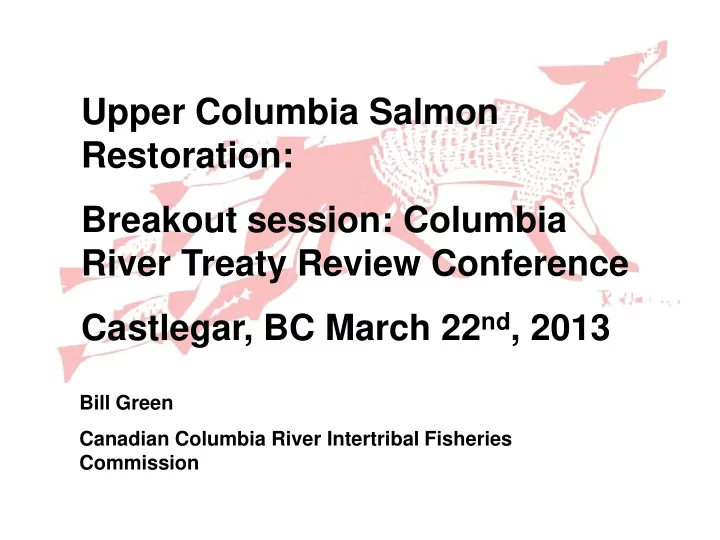

Upper Columbia Salmon Restoration: Breakout session: Columbia River Treaty Review Conference Castlegar, BC March 22 nd , 2013 Bill Green Canadian Columbia River Intertribal Fisheries Commission
Session Outline Presentation (20 min.) • Why now? • History – what has been lost? • Feasibility – Feasibility, impacts and benefits – Provincial concerns – Case studies • Possible next step Questions, comments, discussion (25 min.)
Salmon Restoration: Why now? • Cultural and resource values of tribes and First Nations not considered in 1960’s during Treaty negotiations • Passage costs are less daunting within the context of total Treaty benefits and this review • Profound cultural importance to First Nations and U.S. tribes
Treaty Review offers Opportunity • Comprehensive review of goals and objectives for total river management • River & reservoir operations impact passage potential • Creates a forum for trans-boundary support • Recent positive developments in fish passage technology • Climate Change - access more diverse/cooler habitats
History: What has been lost? Brisco, BC (near Radium) 1930’s Ede family collection
History: What has been lost? Celilo Falls, WA/OR Fishing for ‘June Hogs’ Probably destined for the upper Columbia
Some historic salmon spawning and rearing areas in the upper Columbia
Some historic First Nations salmon fishing locations in the upper Columbia
History: What has been lost? • Sockeye salmon in Arrow, Slocan and Whatshan Lakes (runs of 200 – 400,000 plus) • Summer chinook salmon to the headwaters of the Columbia at Columbia Lake • Fall chinook salmon downstream of Arrow and Slocan Lakes and in the Pend d’Oreille /Salmo • Total chinook runs 300 – 600,000 • Steelhead in the Pend d’Oreille system
History: What has been lost? First Nations harvest (in BC) • Average 200,000 chinook/year • Average 130,000 sockeye/year George Simpson (HBC, 1824): “…mild climate and availability of salmonid resources made the Indians perfectly independent of us” 1939 study indicated that 85 – 90% of the salmon harvested in-river downstream of Rock Island dam were destined for the upper Columbia
Feasibility: Can it be done?
Feasibility: Can it be done? Feasibility, Impacts and Benefits Report, 2007 • Aboriginal rights and title • Government responsibility • Political • Fish passage at dams • Cumulative mortality at downstream dams • Dissolved gases • Operating agreements and laws
Feasibility, Impacts and Benefits Report (2007 – cont’d) • Predation and competition • Genetics and life history • Habitat quality/capacity • Climate warming • Capital and operating costs • Government approvals • Trade-offs PLUS many impacts and benefits questions UNDOUBTEDLY COMPLEX AND DIFFICULT!!
Round Butte Dam, Deschutes River, OR 130 m. high Upstream and downstream passage for chinook salmon
Feasibility of restoring upper Columbia River Salmon: FLNRO views • “In principle, a positive return to former biodiversity” • Current funding inadequate for monitoring and support • Ecological risks need to be addressed
Round Butte Dam: Downstream migrant salmon passage
Deschutes River salmon passage “ To date, about two dozen Chinook and a half- dozen sockeye have been released into Lake Billy Chinook — the first adults above the dams in more than four decades. These are special fish. They were reared above the dams, migrated through the new fish collection facility and have returned after making a round-trip journey to the Pacific Ocean .” www.deschutespassage.com August 1, 2012
Okanagan River Sockeye Restoration: A Success Story “ BC’s Southern Okanagan sees record sockeye returns” CBC News, July 29 th , 2012 A result of Okanagan Nation Alliance efforts
Okanagan River Sockeye Restoration 1998: 2,000 sockeye spawners 2012: 515,000 sockeye, 90 – 95% Okanagan origin, return to the mouth of the Columbia
Okanagan River Sockeye Restoration • Pass through nine dams on the Columbia River • Fish passage improvements at dams • Improved management of flows out of Okanagan Lake • Okanagan River habitat restoration • Hatchery stocking • Passage at McIntyre and Okanagan falls dams, now into Skaha Lake
Case studies: Key Lessons Deschutes River: • Start simple: “Trap and truck” • Passage technologies for high head dams exist Okanagan River: • From 2,000 to 200,000+ in 14 years • Cumulative survival, upstream and downstream, through nine dams is high enough to allow recovery of populations • Salmon are amazing!
A possible next step Start with decades of research and feasibility studies: engineering, biological, economic, financial, legal, etc. OR? Three year experimental salmon reintroduction to the transboundary reach of the Columbia River (Keenleyside to Coulee)
3 Year Experimental Reintroduction • Chinook salmon • Release marked fish into the transboundary reach • Example: Can adults fins their way from the Grand Coulee headpond to spawn successfully upstream of the border?
3 Year Experimental Reintroduction Pre-introduction studies: • Genetics and donor stock selection • Disease risk assessment and management • Ecological risk assessment • Experimental design
Upper Columbia Salmon Restoration • Questions and discussion • Thank you!
Recommend
More recommend